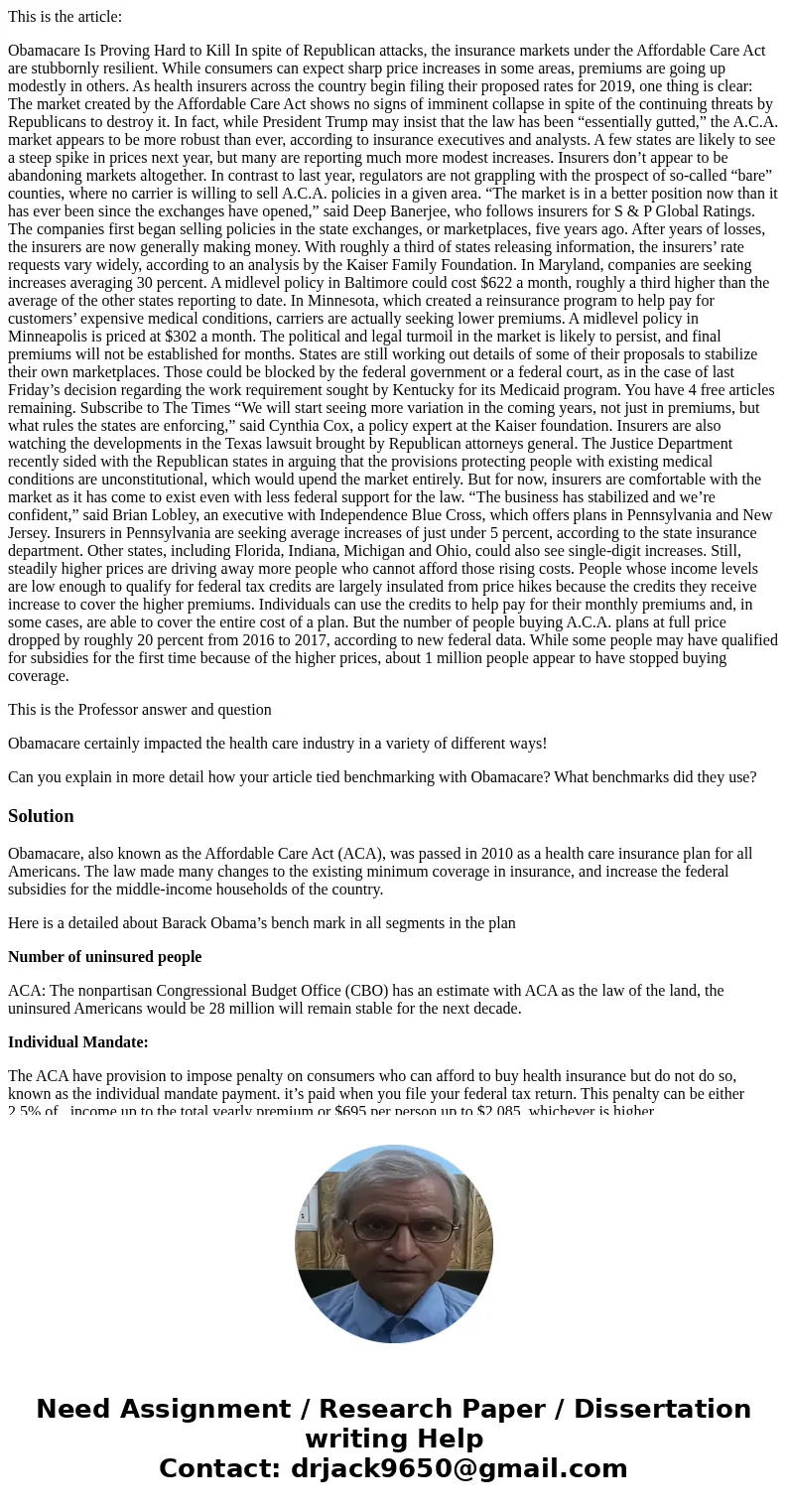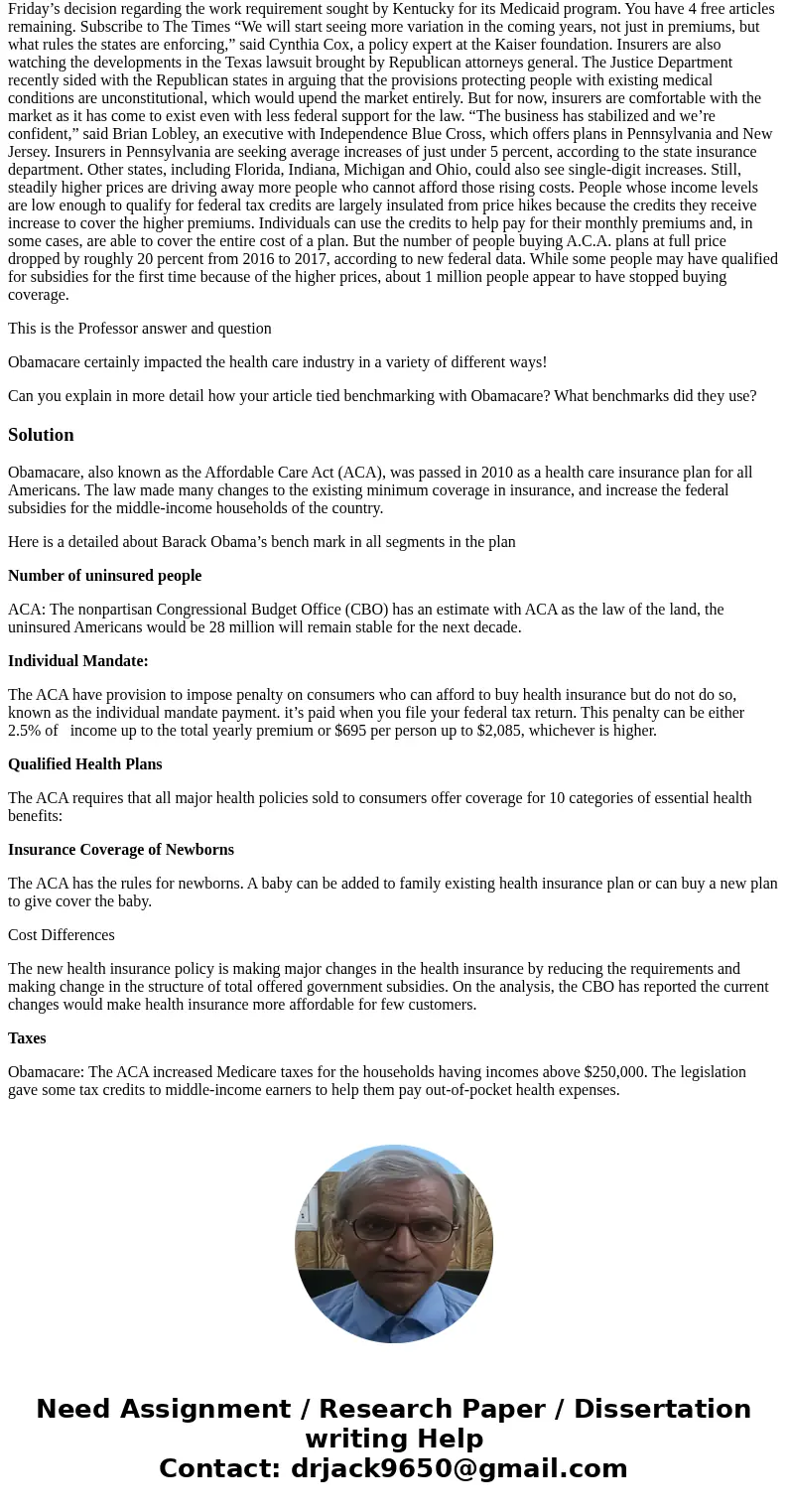This is the article Obamacare Is Proving Hard to Kill In spi
This is the article:
Obamacare Is Proving Hard to Kill In spite of Republican attacks, the insurance markets under the Affordable Care Act are stubbornly resilient. While consumers can expect sharp price increases in some areas, premiums are going up modestly in others. As health insurers across the country begin filing their proposed rates for 2019, one thing is clear: The market created by the Affordable Care Act shows no signs of imminent collapse in spite of the continuing threats by Republicans to destroy it. In fact, while President Trump may insist that the law has been “essentially gutted,” the A.C.A. market appears to be more robust than ever, according to insurance executives and analysts. A few states are likely to see a steep spike in prices next year, but many are reporting much more modest increases. Insurers don’t appear to be abandoning markets altogether. In contrast to last year, regulators are not grappling with the prospect of so-called “bare” counties, where no carrier is willing to sell A.C.A. policies in a given area. “The market is in a better position now than it has ever been since the exchanges have opened,” said Deep Banerjee, who follows insurers for S & P Global Ratings. The companies first began selling policies in the state exchanges, or marketplaces, five years ago. After years of losses, the insurers are now generally making money. With roughly a third of states releasing information, the insurers’ rate requests vary widely, according to an analysis by the Kaiser Family Foundation. In Maryland, companies are seeking increases averaging 30 percent. A midlevel policy in Baltimore could cost $622 a month, roughly a third higher than the average of the other states reporting to date. In Minnesota, which created a reinsurance program to help pay for customers’ expensive medical conditions, carriers are actually seeking lower premiums. A midlevel policy in Minneapolis is priced at $302 a month. The political and legal turmoil in the market is likely to persist, and final premiums will not be established for months. States are still working out details of some of their proposals to stabilize their own marketplaces. Those could be blocked by the federal government or a federal court, as in the case of last Friday’s decision regarding the work requirement sought by Kentucky for its Medicaid program. You have 4 free articles remaining. Subscribe to The Times “We will start seeing more variation in the coming years, not just in premiums, but what rules the states are enforcing,” said Cynthia Cox, a policy expert at the Kaiser foundation. Insurers are also watching the developments in the Texas lawsuit brought by Republican attorneys general. The Justice Department recently sided with the Republican states in arguing that the provisions protecting people with existing medical conditions are unconstitutional, which would upend the market entirely. But for now, insurers are comfortable with the market as it has come to exist even with less federal support for the law. “The business has stabilized and we’re confident,” said Brian Lobley, an executive with Independence Blue Cross, which offers plans in Pennsylvania and New Jersey. Insurers in Pennsylvania are seeking average increases of just under 5 percent, according to the state insurance department. Other states, including Florida, Indiana, Michigan and Ohio, could also see single-digit increases. Still, steadily higher prices are driving away more people who cannot afford those rising costs. People whose income levels are low enough to qualify for federal tax credits are largely insulated from price hikes because the credits they receive increase to cover the higher premiums. Individuals can use the credits to help pay for their monthly premiums and, in some cases, are able to cover the entire cost of a plan. But the number of people buying A.C.A. plans at full price dropped by roughly 20 percent from 2016 to 2017, according to new federal data. While some people may have qualified for subsidies for the first time because of the higher prices, about 1 million people appear to have stopped buying coverage.
This is the Professor answer and question
Obamacare certainly impacted the health care industry in a variety of different ways!
Can you explain in more detail how your article tied benchmarking with Obamacare? What benchmarks did they use?
Solution
Obamacare, also known as the Affordable Care Act (ACA), was passed in 2010 as a health care insurance plan for all Americans. The law made many changes to the existing minimum coverage in insurance, and increase the federal subsidies for the middle-income households of the country.
Here is a detailed about Barack Obama’s bench mark in all segments in the plan
Number of uninsured people
ACA: The nonpartisan Congressional Budget Office (CBO) has an estimate with ACA as the law of the land, the uninsured Americans would be 28 million will remain stable for the next decade.
Individual Mandate:
The ACA have provision to impose penalty on consumers who can afford to buy health insurance but do not do so, known as the individual mandate payment. it’s paid when you file your federal tax return. This penalty can be either 2.5% of income up to the total yearly premium or $695 per person up to $2,085, whichever is higher.
Qualified Health Plans
The ACA requires that all major health policies sold to consumers offer coverage for 10 categories of essential health benefits:
Insurance Coverage of Newborns
The ACA has the rules for newborns. A baby can be added to family existing health insurance plan or can buy a new plan to give cover the baby.
Cost Differences
The new health insurance policy is making major changes in the health insurance by reducing the requirements and making change in the structure of total offered government subsidies. On the analysis, the CBO has reported the current changes would make health insurance more affordable for few customers.
Taxes
Obamacare: The ACA increased Medicare taxes for the households having incomes above $250,000. The legislation gave some tax credits to middle-income earners to help them pay out-of-pocket health expenses.


 Homework Sourse
Homework Sourse